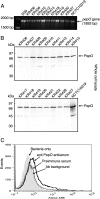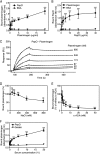Streptococcus pneumoniae endopeptidase O (PepO) is a multifunctional plasminogen- and fibronectin-binding protein, facilitating evasion of innate immunity and invasion of host cells
- PMID: 23341464
- PMCID: PMC3591595
- DOI: 10.1074/jbc.M112.405530
Streptococcus pneumoniae endopeptidase O (PepO) is a multifunctional plasminogen- and fibronectin-binding protein, facilitating evasion of innate immunity and invasion of host cells
Abstract
Streptococcus pneumoniae infections remain a major cause of morbidity and mortality worldwide. Therefore a detailed understanding and characterization of the mechanism of host cell colonization and dissemination is critical to gain control over this versatile pathogen. Here we identified a novel 72-kDa pneumococcal protein endopeptidase O (PepO), as a plasminogen- and fibronectin-binding protein. Using a collection of clinical isolates, representing different serotypes, we found PepO to be ubiquitously present both at the gene and protein level. In addition, PepO protein was secreted in a growth phase-dependent manner to the culture supernatants of the pneumococcal isolates. Recombinant PepO bound human plasminogen and fibronectin in a dose-dependent manner and plasminogen did not compete with fibronectin for binding PepO. PepO bound plasminogen via lysine residues and the interaction was influenced by ionic strength. Moreover, upon activation of PepO-bound plasminogen by urokinase-type plasminogen activator, generated plasmin cleaved complement protein C3b thus assisting in complement control. Furthermore, direct binding assays demonstrated the interaction of PepO with epithelial and endothelial cells that in turn blocked pneumococcal adherence. Moreover, a pepO-mutant strain showed impaired adherence to and invasion of host cells compared with their isogenic wild-type strains. Taken together, the results demonstrated that PepO is a ubiquitously expressed plasminogen- and fibronectin-binding protein, which plays role in pneumococcal invasion of host cells and aids in immune evasion.
Figures









References
-
- Cartwright K. (2002) Pneumococcal disease in Western Europe. Burden of disease, antibiotic resistance and management. Eur. J. Pediatr. 161, 188–195 - PubMed
-
- O'Brien K. L., Wolfson L. J., Watt J. P., Henkle E., Deloria-Knoll M., McCall N., Lee E., Mulholland K., Levine O. S., Cherian T. (2009) Burden of disease caused by Streptococcus pneumoniae in children younger than 5 years. Global estimates. Lancet 374, 893–902 - PubMed
-
- Bergmann S., Hammerschmidt S. (2006) Versatility of pneumococcal surface proteins. Microbiology 152, 295–303 - PubMed
-
- Kadioglu A., Weiser J. N., Paton J. C., Andrew P. W. (2008) The role of Streptococcus pneumoniae virulence factors in host respiratory colonization and disease. Nat. Rev. Microbiol. 6, 288–301 - PubMed
Publication types
MeSH terms
Substances
LinkOut - more resources
Full Text Sources
Other Literature Sources
Molecular Biology Databases

